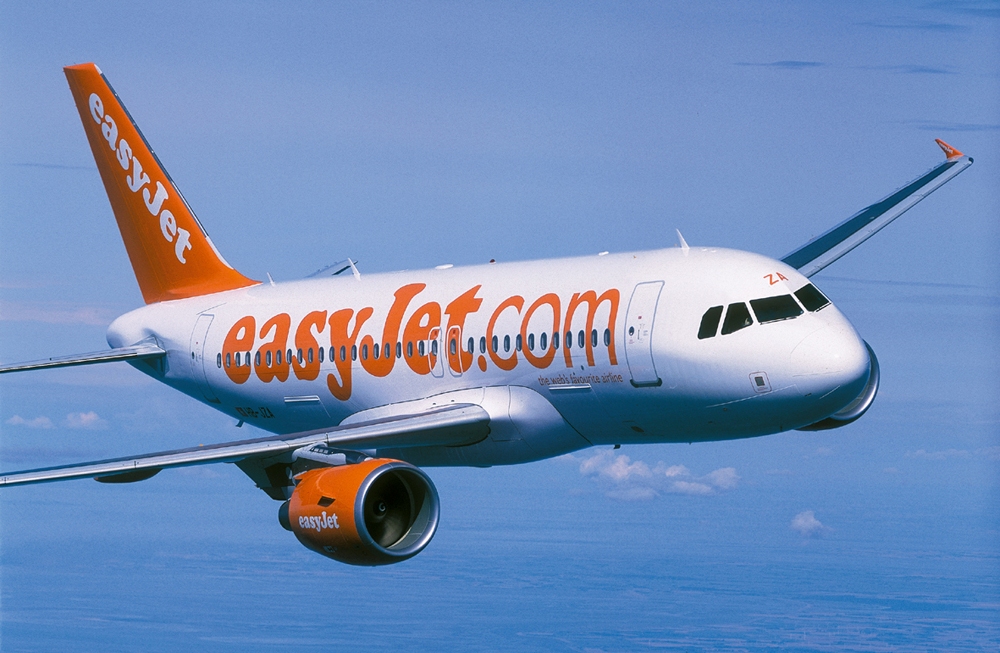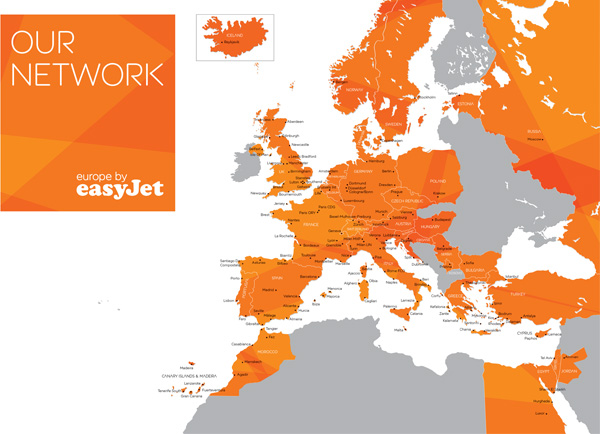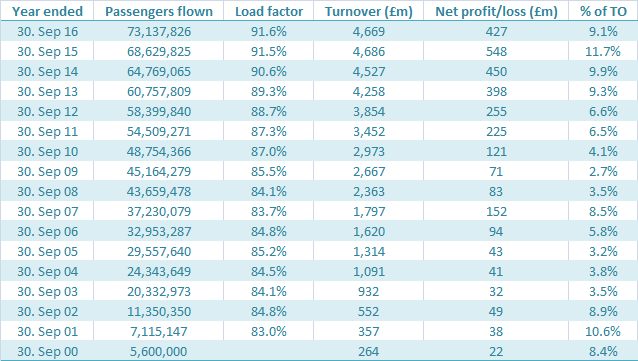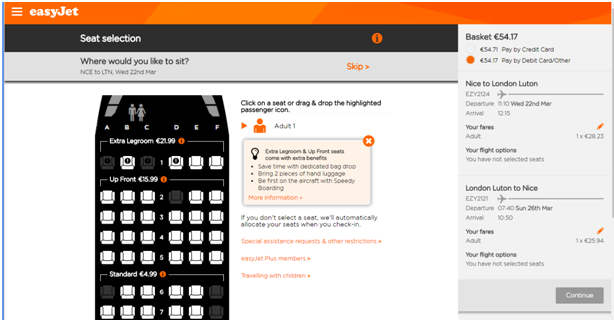Leeham News and Analysis
There's more to real news than a news release.
easyJet, the Ryanair follower
By Bjorn Fehrm
-March 22, 2017, ©. Leeham Co: easyJet started 10 years after Ryanair, using the same Southwest Airlines derived Low Cost Carrier (LCC) business model.
easyJet has been expanding at the pace of Ryanair over the years, trailing the European LCC pioneer by around 20% to 30% of passengers carried each year.
For the last fiscal year ending 30 September 2016, easyJet carried 73 million passengers between 30 countries, flying 820 different routes.
Product
The airline started 10 years after Ryanair, in 1995. It operates the LCC model, but in a slightly different way to Ryanair. Where Ryanair flies to secondary airports like Beauvais for Paris flights, easyJet flies to Charles de Gaulle and Orly, the main airports.
Both airlines developed fast and at about the same rate. easyJet shadowed Ryanair’s growth at about three quarters the size.
Ryanair’s profile is the more uncompromising Low Cost model with rather sterile cabins in black leather, lacking of any seat pockets. easyJet’s cabins are like an all-economy class mainline airline, but with a bit less pitch (18 inch seats at 29 inch pitch).
I have flown easyJet often and I find their product, including seats and the offered legroom, OK for intra-Europe flights (I’m no midget at 6ft and of ordinary build).
Network
easyJet flies between practically all Western European cities, Figure 1. The network gets thinner on the North and East sides of Europe. The airline’s origin was in Luton, England, north of London. Luton is still the main base, but London Gatwick is the busiest easyJet airport.
Financials
easyJet has had good profitability since its start. Over the last 16 years, profits hovered around 7% of turnover, Figure 2. This is not Ryanair-class, but higher than all mainline airlines in Europe.
Cost are higher than for Ryanair (Figure 3), mainly due to the use of mainstream airports but also due to a different personnel policy. easyJet has its own flight crews as opposed to Rynair’s mostly outsourced crews.
Return on capital employed is 14.5%, a good value (Figure 4), but down from previous years.
This consistent profitability allowed the gradual build up of the balance sheet. The balance sheet is strong (Figure 5), with shareholders capital now at 49% of total balance sheet value.
Fleet
The present and future fleet is shown in Figure 6. easyJet will gradually transit from an A319 based fleet to focus on a fleet with A320s and A320neos with 186 seats.
Fleet costs are low (Figure 3), a result of focusing on one aircraft variant and two models (A319/A320) with a lot in common.
Booking
easyJet started with telephone-based booking, but since the end of 1990 has a Web-based booking system. The Web interface is a bit tedious with the usual “Should you need a hotel room/car/insurance/…..” nagging, Figure 7.
I normally spend the money to book a seat. This gives you Speedy boarding, which is convenient (you enter first, like business class in mainline airlines). The seat could also have more legroom if the exit seats are still available.
Hand luggage is no extra cost at easyJet, but the airline is very strict on one bag and its size. Hold luggage cost extra.
Summary
There is little difference between flying easyJet and a mainline airline like British Airways (BA) or Lufthansa for intra-Europe flights. There is no big difference in comfort level anymore (the mainline airlines have all followed the LCCs and made their cabins denser) and you have to pay for your drink and snack on BA from 2017. So no difference there.
If there is an easyJet flight to where I want to go, I book with the same expectation of trip experience as with any mainline airline. This can’t be said of Ryanair.










“I normally spend the money to book a seat. This gives you Speedy boarding”
I booked a flight with Easyjet yesterday. I paid for seat reservation, but my boarding card says: “Speedy boarding: No”.
Speedy boarding (which I really value the most) used to be a separate option and easy to find. At 15 Euro it was good value for money. Now it’s hidden in other perks and quite frankly I often don’t know if I booked it or not. This is something easyJet should fix.
Confusion marketing ? Its deliberate not a bug
“Luton is still the main base, but London Gatwick is the second-busiest easyJet airport.”
Gatwick is easyJet’s busiest airport by a significant margin. Luton is a fraction of the size, there just happens to be a head office there.
Thanks, fixed.
“Hand luggage is no extra cost at easyJet (it is at Ryanair)…”
Since when? Ryanair has always had one of the more generous free hand luggage allowances. Recent experience and a quick check of their website confirms this to remain the case.
Oops, got that wrong guys. Fixed. Not a very frequent Ryanair flier I guess.
Ryanair does not charge for cabin baggage and allows two items rather than Easyjet’s one, although the second is small.
BA started charging in January, not last year.
OK, changed.
I have no idea why, but it seems to me that easyjet crew are unusually cheerful.
Ryanair originally led in the uncompromising LCC model, but ultimately found that this market was limited and then had to follow easyJet in offering a more appealing product to business and premium passengers after poor financial results in 2014. This transformation is still ongoing and I wonder what amount of money Ryanair has had to invest in slowly transforming itself into a brand with an improved consumer reputation. A high price to pay for MoL ‘leadership’.
Does easyJet transports cargo?
Although Easyjet started 10 (actually 11 I think) years after Ryanair, Ryanair was a very different airline pre-1992. So the real world difference is actually 3 years.
Also, I’m not sure it is really fair to call Easyjet a Ryanair follower, except in seeing the potential for a Europe wide, low cost base airline that allowed passengers to book single tickets (rather than selling only return tickets as other UK/Irish carriers did at the time). The way they’ve gone about it (at least in part through acquisition rather than wholly organic, the airport choices, the flight departure times earlier in history IIRC, the mentioned organisational structure differences and approach to the balance sheet) and what seemed to be Stelios’ interest in building a raft of Easy ventures (a la Branson’s Virgin, unlike Ryanair’s airline focus) seem quite different to me.
I remember in th early days Easyjet flew to the bigger airports, unlike Ryanair who flew from secondary airports. Don’t know the stuation now. In general I think Easyjet has a better image in Europe, but that subjective.
Easyjet, Frontier, Spirit, and Ryanair, next stop the 250 seat node? Single aisle or twin aisle?
Easyjet Switzerland is a franchise 49% owned by the parent company
Pingback: » Daily Aviation Brief – 23/03/2017
It will be interesting to see what option they take following the Brexit. Just setting up a new carrier in eg. Ireland to fly *all* intra-EU routes may raise some arguments, especially if EZY remains majority UK-owned.